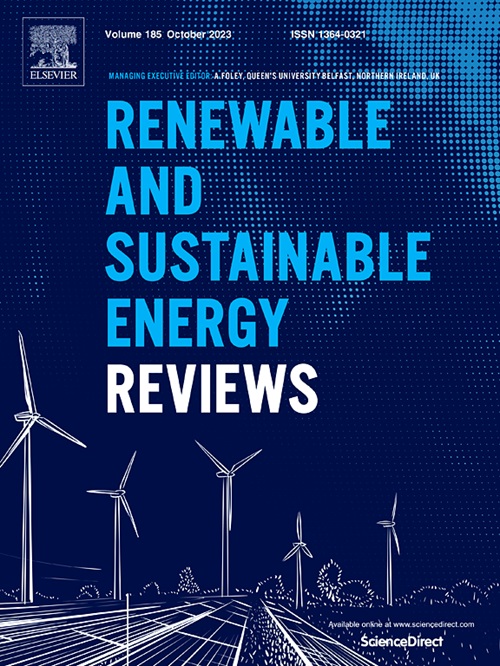考虑可再生能源组合标准和可交易绿色证书的住宅能源
IF 16.3
1区 工程技术
Q1 ENERGY & FUELS
引用次数: 0
摘要
在能源互联网(IoE)中,利用电池储能系统、能源交易和排放交易计划(ETS)优化分布式可再生能源(DRES)的能源管理已引起广泛关注。排放交易计划已扩大到包括排放分散的部门,特别是针对家庭,这与家庭用电越来越多地采用 DRES 是一致的。然而,以往的研究侧重于可再生能源组合标准(RPS)如何影响工业和大型能源系统,而忽视了在家庭层面实施 RPS 的潜力。此外,以往的研究分析了通过与可再生能源发电分离而获得认证的可交易绿色证书(TGCs)能源市场,但很少调查其在家庭中的潜力。因此,本研究将基于家庭的 RPS(HRPS)和 TGCs 拆分引入到一个动态能源管理优化问题中,该问题适用于带有 DRES、家庭储能系统(HESS)和电动汽车的智能家居,其中 HRPS 规定每天消耗绿色能源,允许通过各自的交易平台进行能源和 TGC 交易。本文提出了一个数学编程模型,用于确定家庭储能系统的充电/放电决策、能源交易以及在 HRPS 下的 TGC 交易,同时最大限度地降低成本和对不遵守 HRPS 的惩罚。由于 TGC 分解使该模型变得非常复杂,因此提出了一种简化和谐搜索(SHS)和双适应通用变量邻域搜索(DAGVNS)混合算法。仿真结果表明,引入 RPS 和 TGC 交易可有效减少智能房屋每周约 19.4% 的碳排放量。本文章由计算机程序翻译,如有差异,请以英文原文为准。

Residential energy considering renewable portfolio standards and tradable green certificates
Optimizing energy management for distributed renewable energy sources (DRESs) with battery energy storage systems, energy trading, and emission trading schemes (ETSs) within the Internet of Energy (IoE) has garnered considerable attention. ETSs have been extended to include sectors with dispersed emissions, notably targeting households, aligning with the growing adoption of DRESs for household electricity. However, previous studies focused on how renewable portfolio standard (RPS) that mandates energy suppliers to include a percentage of renewable energy into their energy portfolios influence industrial and large-scale energy systems, neglecting the potential of implementing RPS at the household level. In addition, previous studies analyzed energy markets of traded green certificates (TGCs), certified through their separation from renewable energy generation, but rarely investigated their potential within households. Consequently, this study introduces house-based RPS (HRPS) and the unbundling of TGCs into a dynamic energy management optimization problem for a smart house with DRESs, a home energy storage system (HESS), and an electric vehicle, where HRPS mandates daily consumption of green energy, allowing for energy and TGC trading through their respective trading platforms. A mathematical programming model is formulated for determining HESS charging/discharging decisions, energy trading, and TGC trading under HRPS, while minimizing costs and penalties for HRPS non-compliance. Since TGC unbundling makes this model much complex, a hybrid simplified harmony search (SHS) and double-adaptive general variable neighborhood search (DAGVNS) algorithm is proposed. Simulation results demonstrate that the introduction of RPS and TGC trading can effectively reduce the smart house's carbon emissions by approximately 19.4 % weekly.
求助全文
通过发布文献求助,成功后即可免费获取论文全文。
去求助
来源期刊

Renewable and Sustainable Energy Reviews
工程技术-能源与燃料
CiteScore
31.20
自引率
5.70%
发文量
1055
审稿时长
62 days
期刊介绍:
The mission of Renewable and Sustainable Energy Reviews is to disseminate the most compelling and pertinent critical insights in renewable and sustainable energy, fostering collaboration among the research community, private sector, and policy and decision makers. The journal aims to exchange challenges, solutions, innovative concepts, and technologies, contributing to sustainable development, the transition to a low-carbon future, and the attainment of emissions targets outlined by the United Nations Framework Convention on Climate Change.
Renewable and Sustainable Energy Reviews publishes a diverse range of content, including review papers, original research, case studies, and analyses of new technologies, all featuring a substantial review component such as critique, comparison, or analysis. Introducing a distinctive paper type, Expert Insights, the journal presents commissioned mini-reviews authored by field leaders, addressing topics of significant interest. Case studies undergo consideration only if they showcase the work's applicability to other regions or contribute valuable insights to the broader field of renewable and sustainable energy. Notably, a bibliographic or literature review lacking critical analysis is deemed unsuitable for publication.
 求助内容:
求助内容: 应助结果提醒方式:
应助结果提醒方式:


